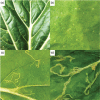Hyperspectral remote sensing to detect leafminer-induced stress in bok choy and spinach according to fertilizer regime and timing
- PMID: 31970888
- PMCID: PMC7317203
- DOI: 10.1002/ps.5758
Hyperspectral remote sensing to detect leafminer-induced stress in bok choy and spinach according to fertilizer regime and timing
Abstract
Background: Detection and diagnosis of emerging arthropod outbreaks in horticultural glasshouse crops, such as bok choy and spinach, is both important and challenging. A major challenge is to accurately detect and diagnose arthropod outbreaks in growing crops (changes in canopy size, structure, and composition), and when crops are grown under three fertilization regimes. Day-time remote sensing inside glasshouses is highly sensitive to inconsistent lighting, spectral scattering, and shadows casted by glasshouse structures. To avoid these issues, a unique feature of this study was that hyperspectral remote sensing data were acquired after sunset with an active light source. As part of this study, we describe a comprehensive approach to performance assessment of classification algorithms based on hyperspectral remote sensing data.
Results: Based on average hyperspectral remote sensing profiles from individual crop plants, none of the 31 individual spectral bands showed consistent significant response to leafminer infestation and non-significant response to fertilizer regime. Multi-band classification algorithms were subjected to a comprehensive performance assessment to quantify risks of model over-fitting and low repeatability of classification algorithms. The performance assessment of classification algorithms addresses the important 'bias-variance trade-off'. Truly independent validation (training and validation data sets being separated over time) revealed that leafminer infestation could be detected with >99% accuracy in both bok choy and spinach.
Conclusion: We conclude that detailed hyperspectral profiles (not single spectral bands) can accurately detect and diagnose leafminer infestation over time and across fertilizer regimes. Hyperspectral remote sensing data acquisition at night with an active light source has the potential to enable arthropod infestations in glasshouse-grown crops, such as, bok choy and spinach. In addition, we conclude that effective use and deployment of hyperspectral remote sensing requires thorough performance assessments of classification algorithms, and we propose an analytical performance method to address this important matter. © 2020 The Authors. Pest Management Science published by John Wiley & Sons Ltd on behalf of Society of Chemical Industry.
Keywords: IPM; bok choy; machine vision; reflectance profiling; spinach.
© 2020 The Authors. Pest Management Science published by John Wiley & Sons Ltd on behalf of Society of Chemical Industry.
Figures




References
-
- Bielza P, Insecticide resistance management strategies against the western flower thrips, Frankliniella occidentalis . Pest Manag Sci 64:1131–1138 (2008). - PubMed
-
- Pilkington LJ, Messelink G, van Lenteren JC and Le Mottee K, “Protected biological control” – biological pest management in the greenhouse industry. Biol Control 52:216–220 (2010).
-
- Berlinger MJ, Jarvis WR, Jewett TJ and Lebiush‐Mordechi S, Managing the greenhouse, crop and crop environment, in Integrated Pest and Disease Management in Greenhouse Crops. Springer, Berlin, pp. 97–123 (1999).
-
- Pedigo L and Rice M, Entomology and Pest Management. Prentice Hall, Upper Saddle River, NJ: (2006).
-
- Stern VM, Smith RF, Rvd B and Hagen KS, Integrated control concept. Hilgardia 29:81–101 (1959).
MeSH terms
Substances
Grants and funding
LinkOut - more resources
Full Text Sources
Other Literature Sources
Research Materials

